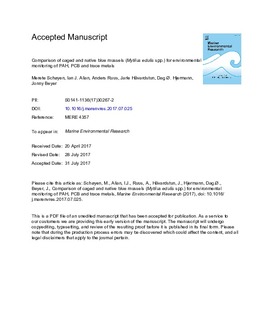| dc.contributor.author | Schøyen, Merete | |
| dc.contributor.author | Allan, Ian | |
| dc.contributor.author | Ruus, Anders | |
| dc.contributor.author | Håvardstun, Jarle | |
| dc.contributor.author | Hjermann, Dag Øystein | |
| dc.contributor.author | Beyer, Jonny | |
| dc.date.accessioned | 2018-04-18T14:05:48Z | |
| dc.date.available | 2018-04-18T14:05:48Z | |
| dc.date.created | 2017-12-09T14:05:43Z | |
| dc.date.issued | 2017 | |
| dc.identifier.citation | Marine Environmental Research. 2017, 130, 221-232. | nb_NO |
| dc.identifier.issn | 0141-1136 | |
| dc.identifier.uri | http://hdl.handle.net/11250/2494880 | |
| dc.description | This is an Accepted Manuscript of an article published by Elsevier in Marine Environmental Research, available online: https://www.elsevier.com/ | nb_NO |
| dc.description.abstract | Contaminant bioaccumulation was studied in blue mussels (Mytilus edulis spp.) using the harbor waters of Kristiansand (Norway) as a case study. A suite of chemical contaminants (trace metals, PAHs and PCBs) was analyzed in caged and native mussels as well as in passive samplers (Diffusive Gradients in Thin films (DGT)-devices and silicone rubbers) placed alongside the mussels for estimation of contaminant concentrations in water and uptake rates and bioaccumulation factors (BAFs) in mussels during a sixmonths deployment period. Estimated logBAFs were in the ranges 2.3e5.5, 3.8e5.2 and 3.2e4.4 for metals, PCBs and PAHs, respectively. Contaminant levels in caged mussels increased rapidly to stable levels for trace metals, whereas for hydrophobic organic contaminants the increase was steady but slow and for many compounds did not reach the levels observed in native mussels. Some key issues related to mussel caging design, such as mussel deployment time and confounding influence from seasonal fluctuations, are discussed herein. | nb_NO |
| dc.language.iso | eng | nb_NO |
| dc.publisher | Elsevier | nb_NO |
| dc.rights | Attribution-NonCommercial-NoDerivatives 4.0 Internasjonal | * |
| dc.rights.uri | http://creativecommons.org/licenses/by-nc-nd/4.0/deed.no | * |
| dc.title | Comparison of caged and native blue mussels (Mytilus edulis spp.) for environmental monitoring of PAH, PCB and trace metals | nb_NO |
| dc.type | Journal article | nb_NO |
| dc.type | Peer reviewed | nb_NO |
| dc.description.version | acceptedVersion | nb_NO |
| dc.rights.holder | © 2017 Elsevier Ltd. All rights reserved. | nb_NO |
| dc.source.pagenumber | 221-232 | nb_NO |
| dc.source.volume | 130 | nb_NO |
| dc.source.journal | Marine Environmental Research | nb_NO |
| dc.identifier.doi | 10.1016/j.marenvres.2017.07.025 | |
| dc.identifier.cristin | 1525161 | |
| dc.relation.project | The Research Council of Norway: NIVA's institutional funding | nb_NO |
| dc.relation.project | Norwegian Environment Agency: National Function programme | nb_NO |
| cristin.unitcode | 7464,20,12,0 | |
| cristin.unitcode | 7464,30,12,0 | |
| cristin.unitcode | 7464,20,14,0 | |
| cristin.unitname | Marin forurensning | |
| cristin.unitname | Akvatiske miljøgifter | |
| cristin.unitname | Marin biogeokjemi og oseanografi | |
| cristin.ispublished | true | |
| cristin.fulltext | postprint | |
| cristin.qualitycode | 2 | |

